A Method to Optimize Dormitory Environments Based on Personnel Behavior Regulation
Abstract
1. Introduction
2. Method
2.1. Questionnaire Setup
2.2. Investigated Cases
2.3. Experimental Setup
2.3.1. Geometry of the Dormitory
2.3.2. Tracer Gas (CO2) Setup and Instruments (Figure 3)
Principle of Calculating the Air Exchange Rate in a Room

Calculation of the Human CO2 Release FR
2.3.3. Pollutant Detection
3. Results
3.1. Questionnaire Results
3.2. Results of the Dynamic Processes of CO2
3.3. Formaldehyde Concentration Levels
4. Discussion
5. Conclusions
Supplementary Materials
Author Contributions
Funding
Data Availability Statement
Acknowledgments
Conflicts of Interest
References
- Pandey, P.R.; Dong, B. Prediction of window opening behavior and its impact on HVAC energy consumption at a residential dormitory using Deep Neural Network. Energy Build. 2023, 296, 113355. [Google Scholar] [CrossRef]
- China’s National Bureau of Statistics: 10.47 Million Undergraduates Graduating in 2023 1.015 Million Postgraduates. Available online: https://news.eol.cn/yaowen/202402/t20240229_2560731.shtml (accessed on 29 February 2024).
- Wang, Z.; Wu, Y.; Jia, Z.; Gao, Q.; Gu, Z. Research on Health and Thermal Comfort of Unit-Type Student Apartments in the Western China Science and Technology Innovation Harbor. Front. Public Health 2022, 10, 850107. [Google Scholar] [CrossRef]
- Yang, Z.; Shen, J.; Gao, Z. Ventilation and Air Quality in Student Dormitories in China: A Case Study during Summer in Nanjing. Int. J. Environ. Res. Public Health 2018, 15, 1328. [Google Scholar] [CrossRef]
- Yang, Z.; Ma, T.; Zhu, Y.; Ai, Y. Psychological Characteristics Analysis of Spatial Environment of College Students’ Dormitory-Taking the Chang’an campus of Northwestern Polytechnical University as an example. Appl. Mech. Mater. 2013, 409–410, 707–712. [Google Scholar] [CrossRef]
- Zhang, W.; Wang, L.; Ji, Z.; Ma, L.; Hui, Y. Test on Ventilation Rates of Dormitories and Offices in University by the CO2 Tracer Gas Method. Procedia Eng. 2015, 121, 662–666. [Google Scholar] [CrossRef]
- Alqarni, Z.; Rezgui, Y.; Petri, I.; Ghoroghi, A. Factors and strategies affecting indoor air quality in educational buildings. In Proceedings of the 2023 IEEE International Conference on Engineering, Technology and Innovation (ICE/ITMC), Edinburgh, UK, 19–22 June 2023; IEEE: New York, NY, USA, 2023; pp. 1–6. [Google Scholar]
- Jin, S.; Zhong, L.; Zhang, X.; Li, X.; Li, B.; Fang, X. Indoor Volatile Organic Compounds: Concentration Characteristics and Health Risk Analysis on a University Campus. Int. J. Environ. Res. Public Health 2023, 20, 5829. [Google Scholar] [CrossRef]
- Jenkins, S.T. Ventilation Impact on Airborne Transmission of Respiratory Illness in Student Dormitories. Master’s Thesis, University of Maryland, College Park, MD, USA, 2018. [Google Scholar]
- Buonomano, A.; Forzano, C.; Giuzio, G.F.; Palombo, A. New ventilation design criteria for energy sustainability and indoor air quality in a post Covid-19 scenario. Renew. Sustain. Energy Rev. 2023, 182, 113378. [Google Scholar] [CrossRef]
- Yang, F.; Sun, Y.; Wang, P.; Weschler, L.B.; Sundell, J. Spread of respiratory infections in student dormitories in China. Sci. Total Environ. 2021, 777, 145983. [Google Scholar] [CrossRef] [PubMed]
- Sun, Z.W.Y.; Yufeng, Z.; Jan, S. In China, Students in Crowded Dormitories with a Low Ventilation Rate Have More Common Colds: Evidence for Airborne Transmission. PLoS ONE 2011, 6, e27140. [Google Scholar] [CrossRef] [PubMed]
- Seppanen, O.A.; Fisk, W.J.; Mendell, M.J. Association of ventilation rates and CO2 concentrations with health and other responses in commercial and institutional buildings. Indoor Air 1999, 9, 226–252. [Google Scholar] [CrossRef]
- Yang, D.; Jiang, L. Simulation study on the Natural Ventilation of College Student’ Dormitory. Procedia Eng. 2017, 205, 1279–1285. [Google Scholar] [CrossRef]
- Li, Z.; Li, K.; Chang, J.; Wu, H.; Liu, J. Numerical simulation the effect of natural ventilation on Indoor Environment Quality in the inner-corridor-type student dormitory in winter. IOP Conf. Ser. Mater. Sci. Eng. 2019, 609, 42016. [Google Scholar] [CrossRef]
- Lei, Z.; Liu, C.; Wang, L.; Li, N. Effect of natural ventilation on indoor air quality and thermal comfort in dormitory during winter. Build. Environ. 2017, 125, 240–247. [Google Scholar] [CrossRef]
- Bastien, D.; Licina, D.; Bourikas, L.; Crosby, S.; Gauthier, S.; Mino-Rodriguez, I.; Piselli, C. The impact of real-time carbon dioxide awareness on occupant behavior and ventilation rates in student dwellings. Energy Build. 2024, 310, 114132. [Google Scholar] [CrossRef]
- Liao, C.; Fan, X.; Bivolarova, M.; Laverge, J.; Sekhar, C.; Akimoto, M.; Mainka, A.; Lan, L.; Wargocki, P. A cross-sectional field study of bedroom ventilation and sleep quality in Denmark during the heating season. J. Affect. Disord. 2022, 224, 109557. [Google Scholar] [CrossRef]
- Franceschini, P.B.; Neves, L.O. A critical review on occupant behaviour modelling for building performance simulation of naturally ventilated school buildings and potential changes due to the COVID-19 pandemic. Energy Build. 2022, 258, 111831. [Google Scholar] [CrossRef]
- Shuai, S.; Xueyi, Z.; Jie, L. Study on Indoor Wind Environment of Student Dormitory of Shandong Jianzhu University. Build. Energy Effic. 2017, 45, 51–54. [Google Scholar]
- Wang, Y.; Yu, Y.; Ye, T.; Bo, Q. Ventilation Characteristics and Performance Evaluation of Different Window-Opening Forms in a Typical Office Room. Appl. Sci. 2021, 11, 8966. [Google Scholar] [CrossRef]
- Sun, B.; Yang, Z.H. A Numerical Simulation of VOCs Distribution in Indoor Environment of a Dormitory. Innov. Solut. Mater. Sci. Eng. 2014, 548–549, 650–654. [Google Scholar]
- Chen, X.; Liu, M. Simulation and On-site Measurement of Heating Performance in Air-conditioned University Dormitories, a Case Study in Chongqing. Procedia Eng. 2017, 205, 2569–2576. [Google Scholar] [CrossRef]
- Yang, J.; Wu, X.; Chan, K.T.; Yang, X. Measurement and Analysis of Indoor Air Quality in the University Dormitories. In Proceedings of the 2009 3rd International Conference on Bioinformatics and Biomedical Engineering, Beijing, China, 11–13 June 2009; pp. 1–4. [Google Scholar] [CrossRef]
- Liu, J.; Dai, X.; Li, X.; Jia, S.; Pei, J.; Sun, Y.; Lai, D.; Shen, X.; Sun, H.; Yin, H.; et al. Indoor air quality and occupants’ ventilation habits in China: Seasonal measurement and long-term monitoring. Build. Environ. 2018, 142, 119–129. [Google Scholar] [CrossRef]
- Choe, Y.; Shin, J.; Park, J.; Kim, E.; Oh, N.; Min, K.; Kim, D.; Sung, K.; Cho, M.; Yang, W. Inadequacy of air purifier for indoor air quality improvement in classrooms without external ventilation. Build. Environ. 2022, 207, 108450. [Google Scholar] [CrossRef]
- Zhang, N.; Jin, W.; He, J. Experimental Study on the Influence of Ventilated Window on Indoor Air Quality and Energy Consumption. Procedia Eng. 2016, 146, 296–302. [Google Scholar] [CrossRef]
- Rigger, P.; Wortmann, F.; Dahlinger, A. Design Science in Practice: Design and Evaluation of an Art Based Information System to Improve Indoor Air Quality at Schools. In New Horizons in Design Science: Broadening the Research Agenda; Springer International Publishing: Cham, Switzerland, 2015; pp. 71–86. [Google Scholar]
- Yoo, J.; Kim, S.; Qi, L.; Choi, S.; Bae, J.; Park, J.; Li, A.; Olofsson, T.; Kosonen, R. An Analysis of Natural Ventilation and Ventilation load in relation to Occupants’ window opening Behaviour in residential Building. E3S Web Conf. 2022, 356, 3054. [Google Scholar] [CrossRef]
- Korsavi, S.S.; Jones, R.V.; Fuertes, A. Operations on windows and external doors in UK primary schools and their effects on indoor environmental quality. Build. Environ. 2022, 207, 108416. [Google Scholar] [CrossRef]
- Jin, W.; Zhang, N.; He, J. Experimental Study on the Influence of a Ventilated Window for Indoor Air Quality and Indoor Thermal Environment. Procedia Eng. 2015, 121, 217–224. [Google Scholar] [CrossRef]
- Fazlzadeh, M.; Hassanvand, M.S.; Nabizadeh, R.; Shamsipour, M.; Salarifar, M.; Naddafi, K. Effect of portable air purifier on indoor air quality: Reduced exposure to particulate matter and health risk assessment. Environ. Monit. Assess. 2022, 194, 638. [Google Scholar] [CrossRef]
- Zhang, H.; Liu, Z. Influence of winter natural ventilation on thermal environment of university dormitories under central heating mode in severe cold regions of China. Arch. Sci. Rev. 2023, 66, 226–241. [Google Scholar] [CrossRef]
- ANSI/ASHRAE Standard 55-2017; Thermal Environmental Conditions for Human Occupancy. ASHRAE: Peachtree Corners, GA, USA, 2017.
- Olesen, B.W. ASHRAE’s history with thermal comfort. ASHRAE J. 2020, 62, 32–39. [Google Scholar]
- ANSI/ASHRAE Standard 62.2-2022; Ventilation and Acceptable Indoor Air Quality in Residential Buildings. American National Standards Institute: Washington, DC, USA, 2022.
- GB/T 18883-2022; China National Indoor Air Quality Standards. China National Standards: Beijing, China, 2022.
- Li, H.; Li, X.; Qi, M. Field testing of natural ventilation in college student dormitories (Beijing, China). Build. Environ. 2014, 78, 36–43. [Google Scholar] [CrossRef]
- Persily, A. Evaluating building IAQ and ventilation with indoor CO2. ASHRAE Trans. 1996, 103, 193–204. [Google Scholar]
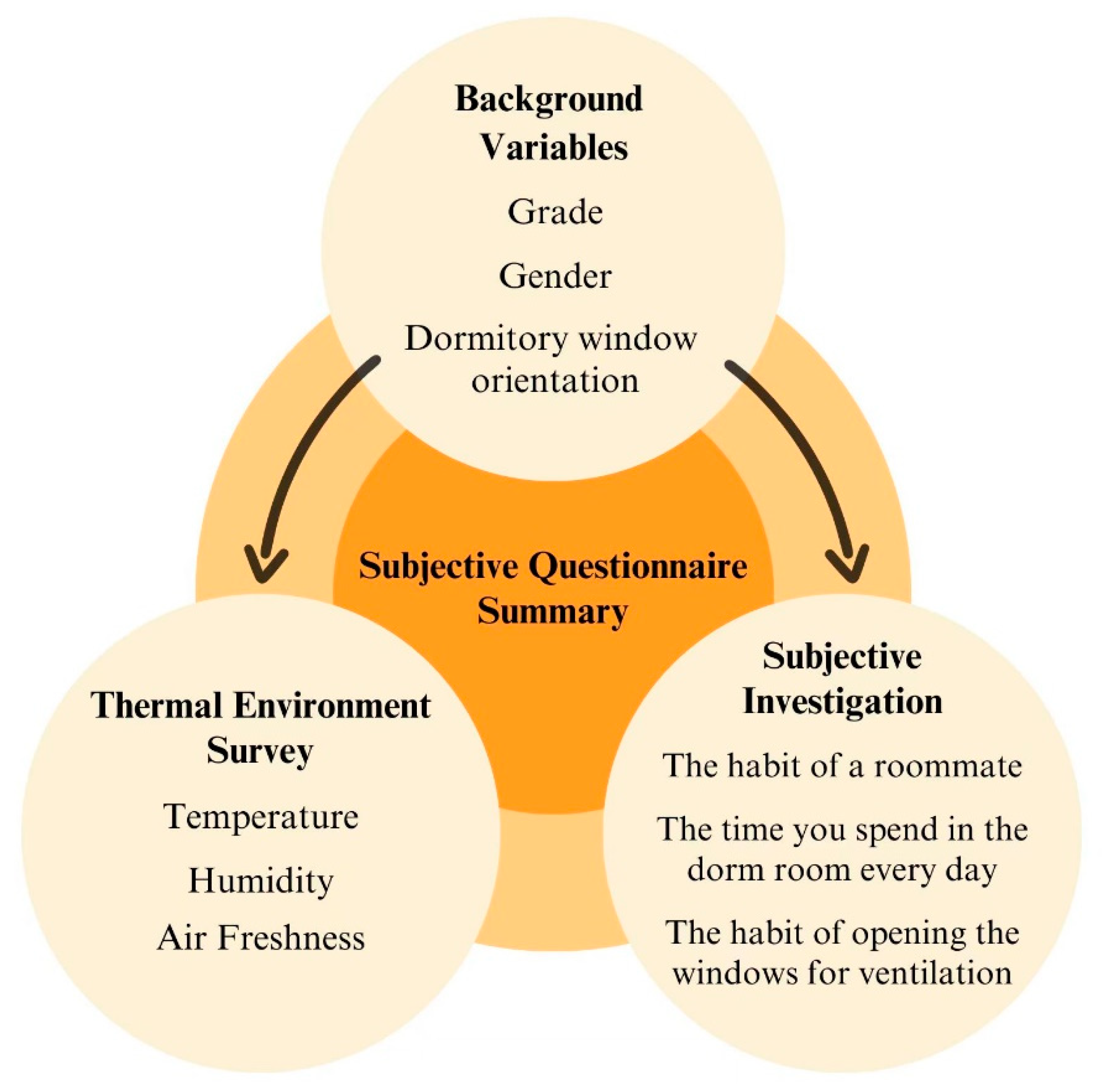
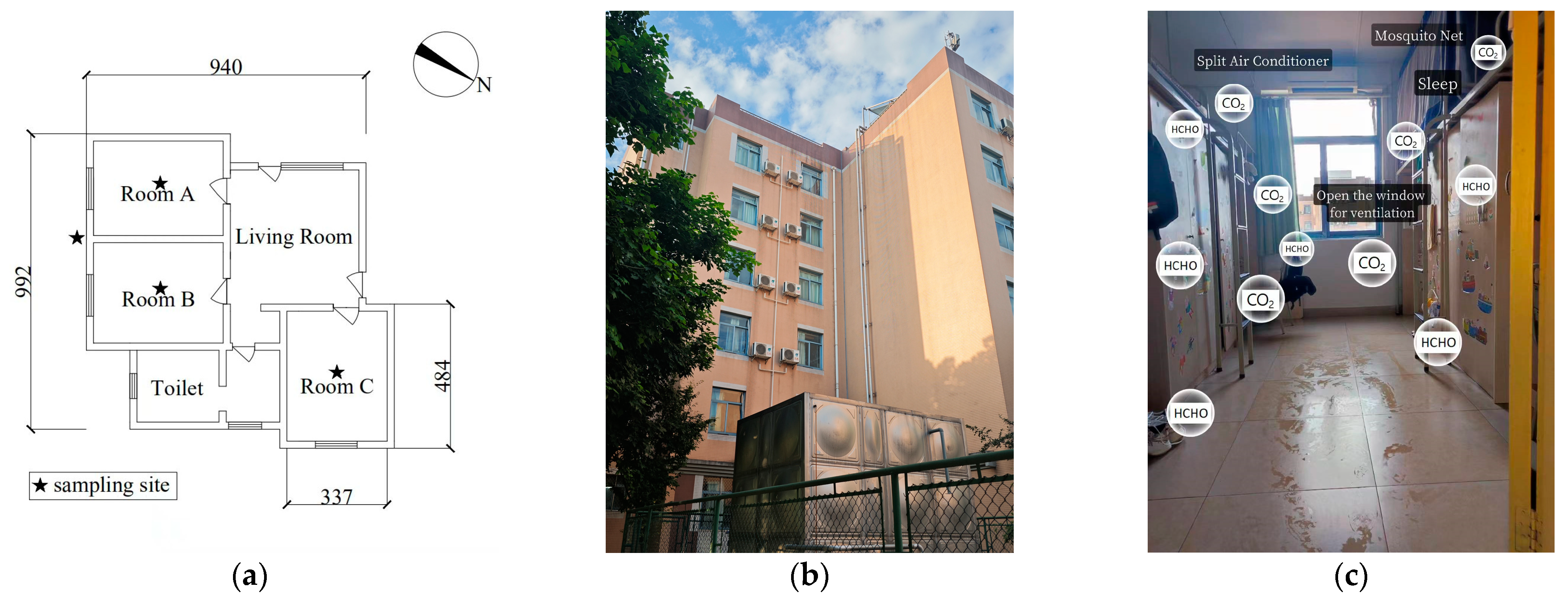



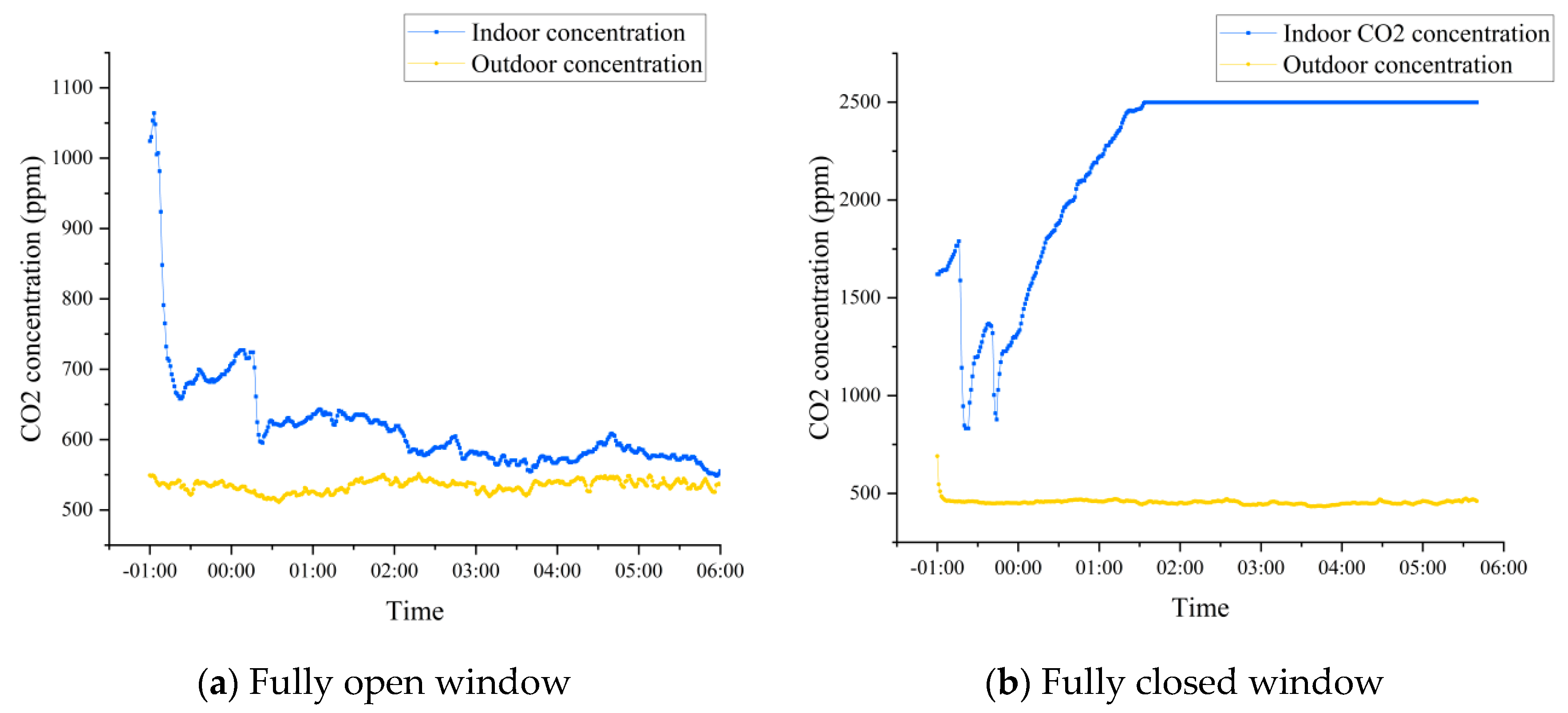
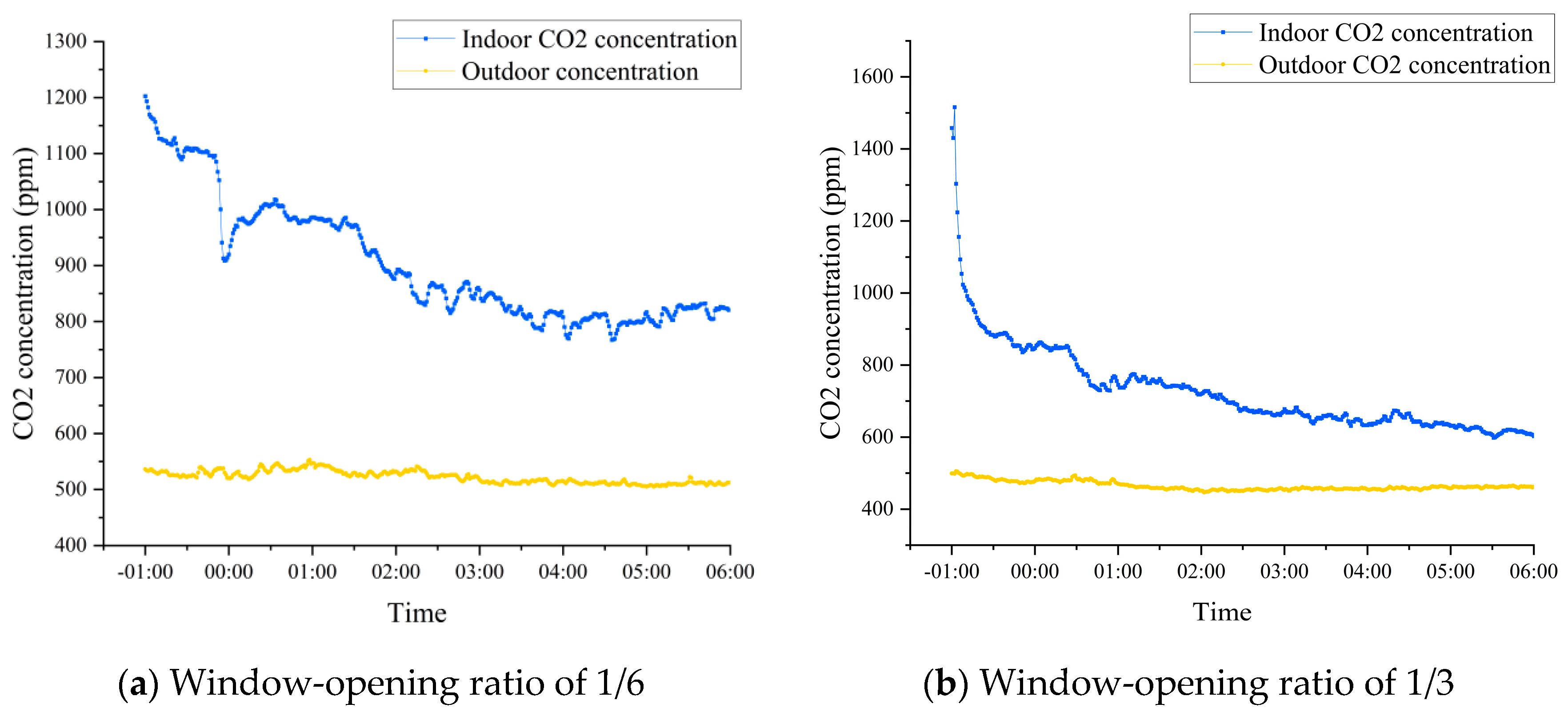

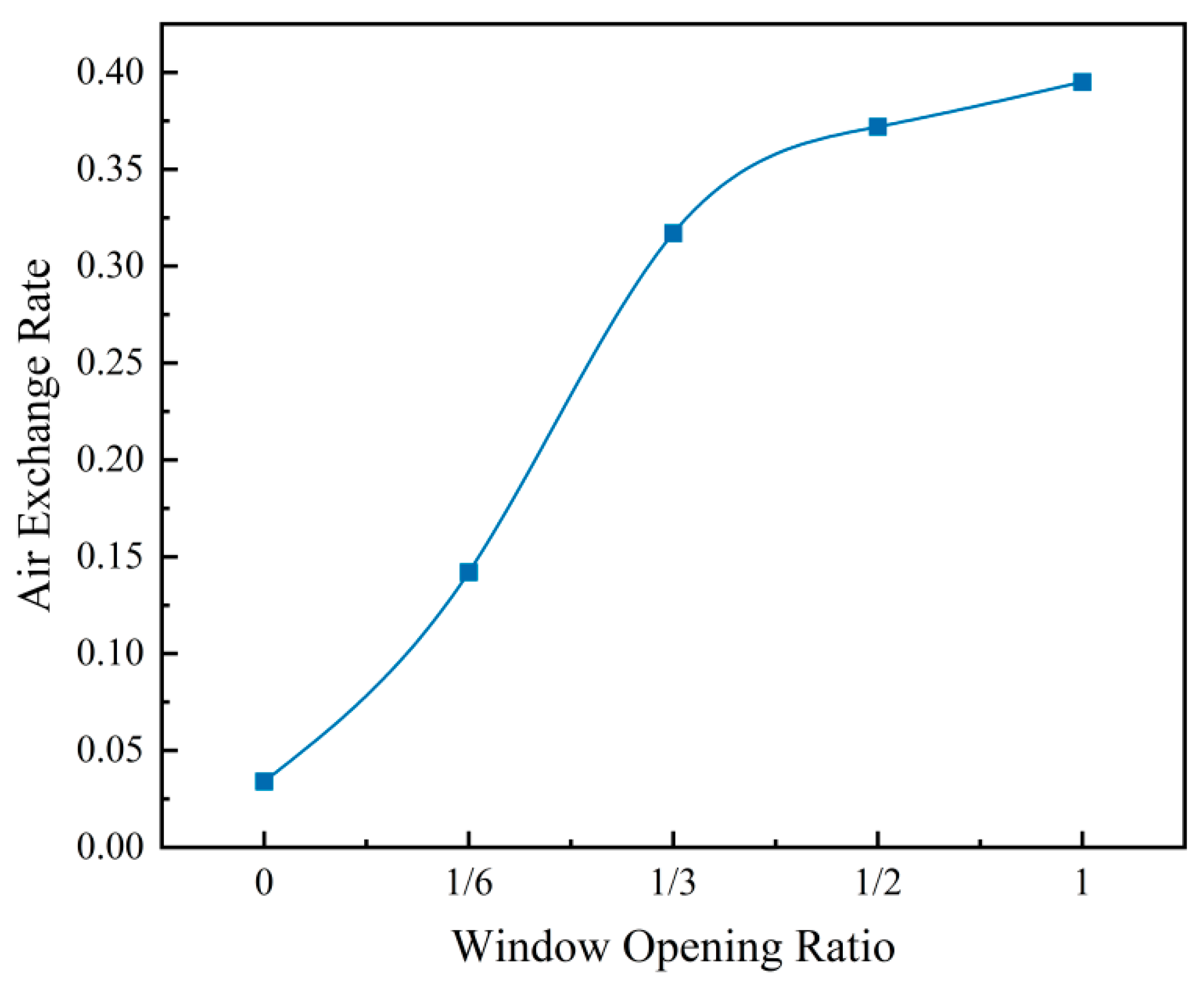
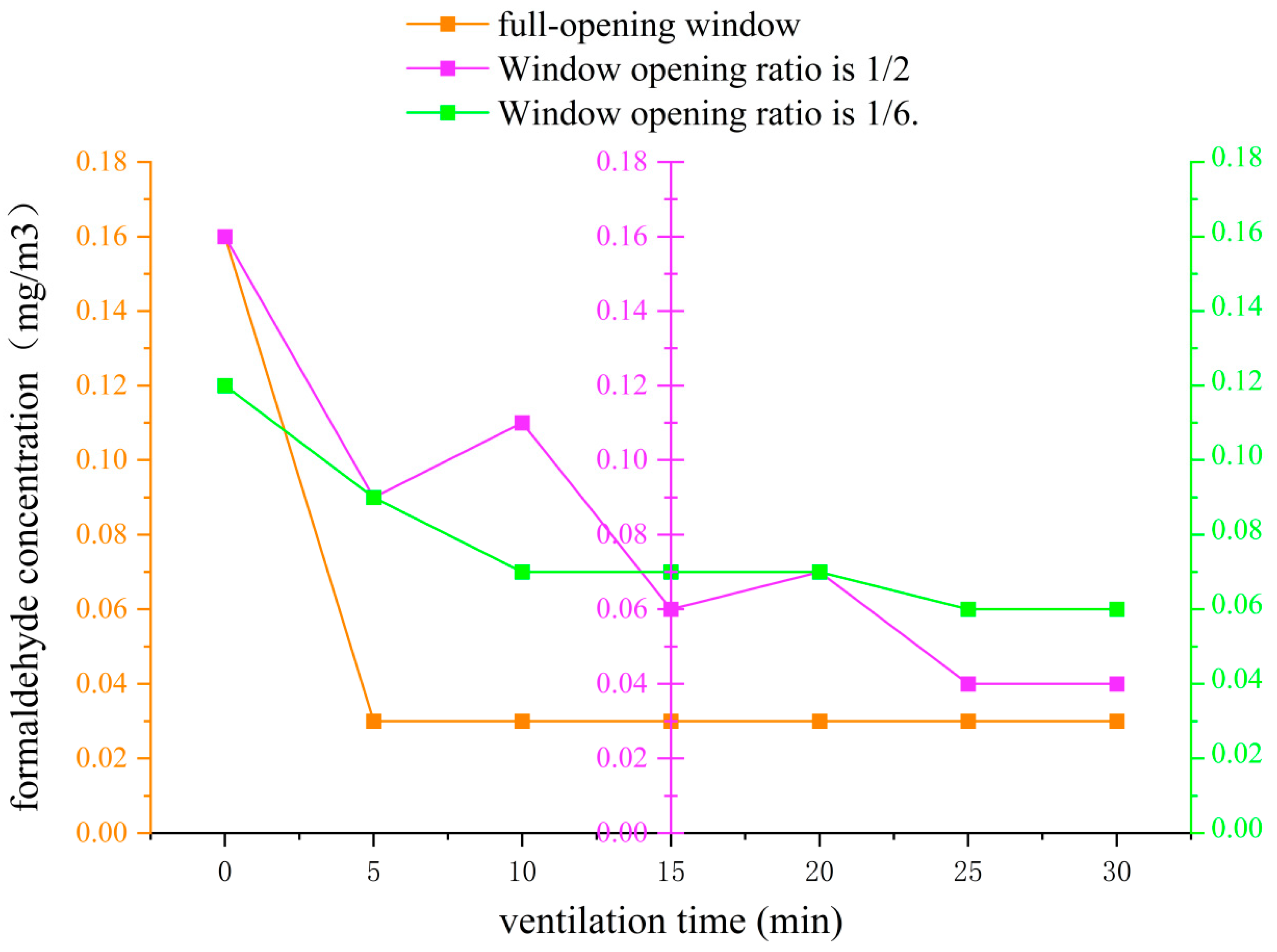
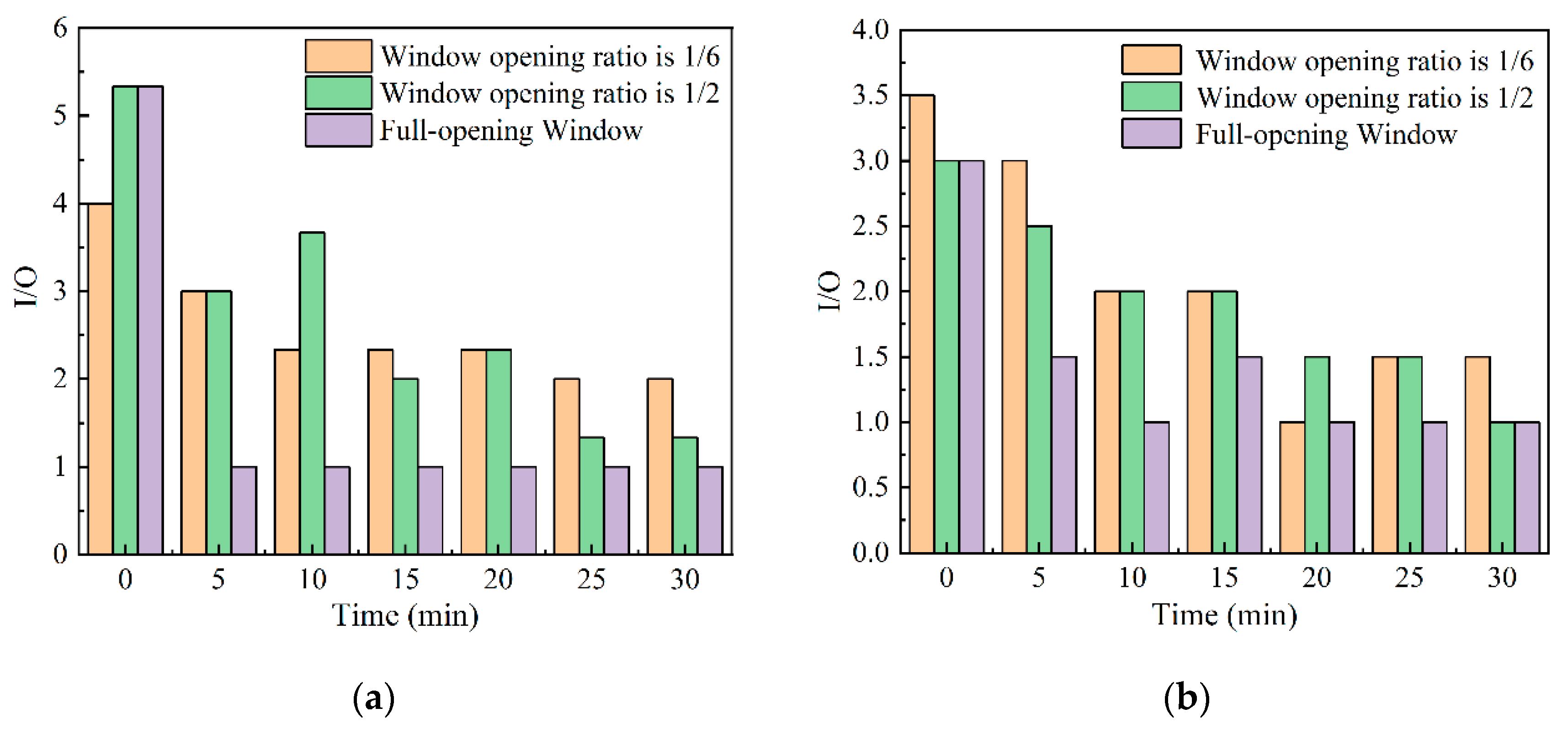
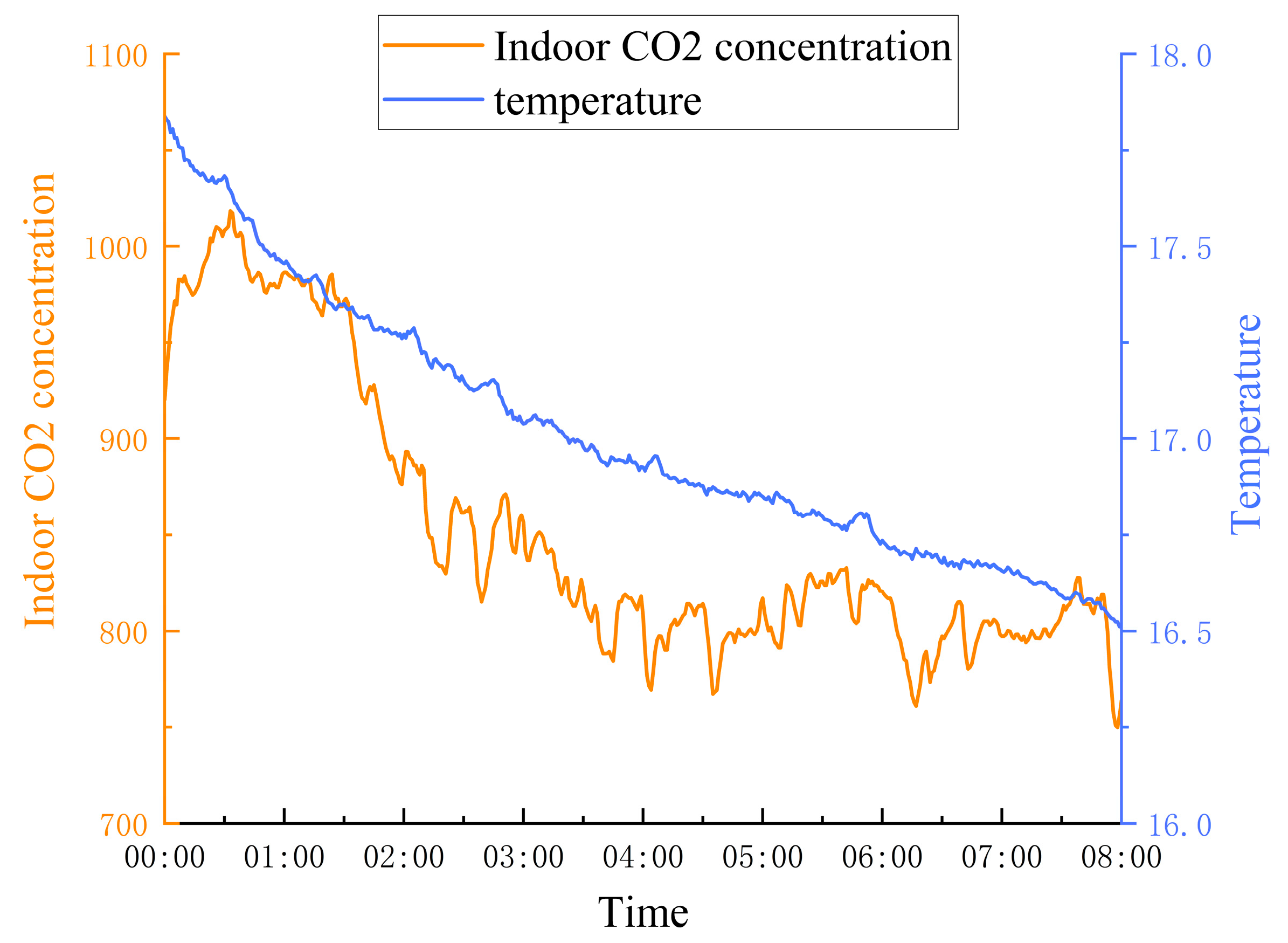
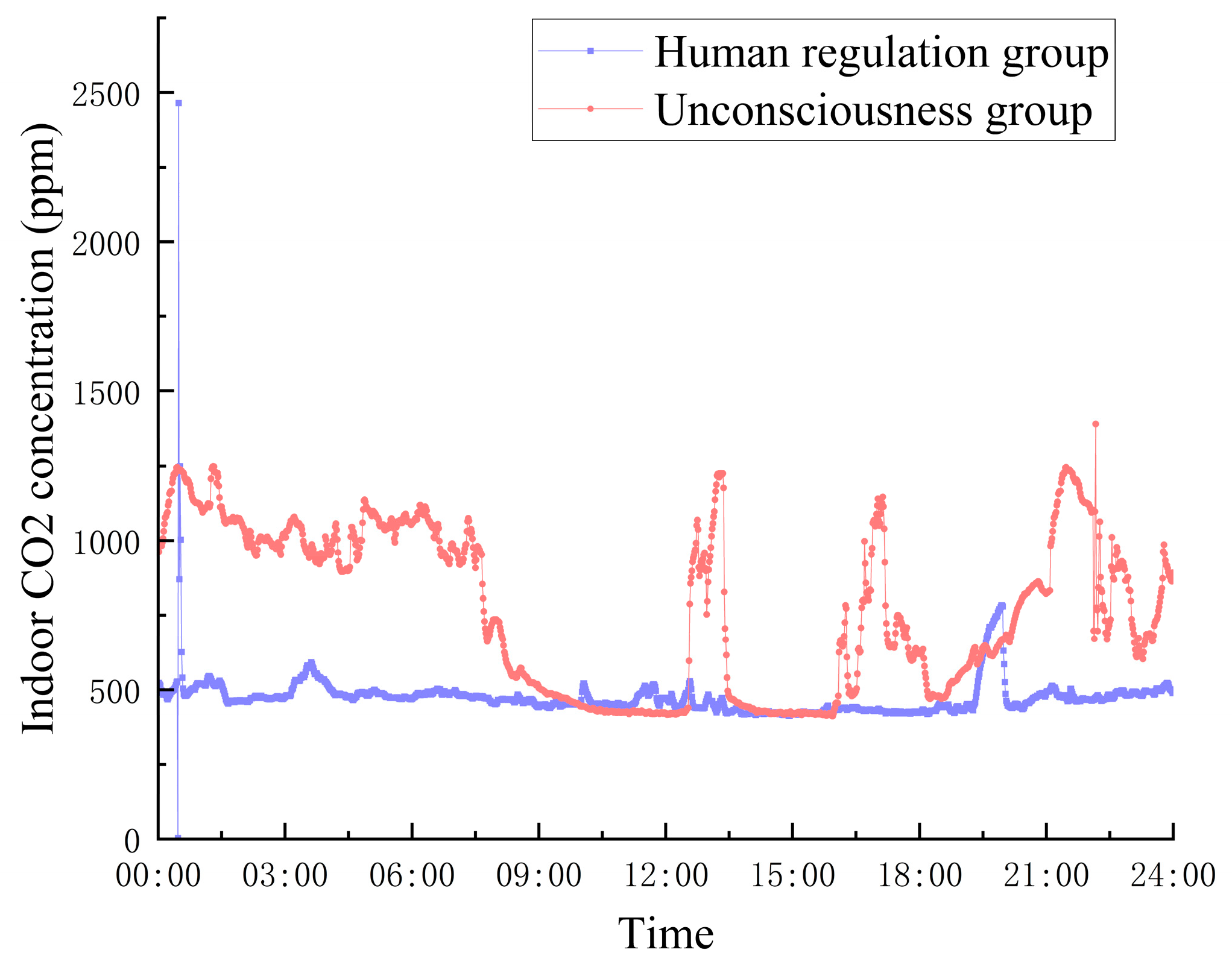
| Model | Measuring Variable | Range | Accuracy | Resolution |
|---|---|---|---|---|
| Performance: CO2 Channel | CO2 Concentration | 0–10,000 ppm | ±50 ppm | ±1 ppm |
| Performance: Temperature Channel | Temperature | Display: 32 to 122 °F (0–50 °C) | ±2 °F (±1 °C) | 0.1 °F (0.1 °C) |
| Model | Measuring Variable | Range | Accuracy | Resolution |
|---|---|---|---|---|
| PPM-htV | Formaldehyde Concentration | 0.00–10.00 ppm | 2% | ±0.01 ppm |
| Standard | ISO | ASHRAE | CEN |
|---|---|---|---|
| Air exchange rate | 0.5–1.0 | 0.5 | 0.5–1 |
Disclaimer/Publisher’s Note: The statements, opinions and data contained in all publications are solely those of the individual author(s) and contributor(s) and not of MDPI and/or the editor(s). MDPI and/or the editor(s) disclaim responsibility for any injury to people or property resulting from any ideas, methods, instructions or products referred to in the content. |
© 2024 by the authors. Licensee MDPI, Basel, Switzerland. This article is an open access article distributed under the terms and conditions of the Creative Commons Attribution (CC BY) license (https://creativecommons.org/licenses/by/4.0/).
Share and Cite
Yang, X.; Zhang, J.; Cheng, Y.; Weng, X.; Yin, R.; Guo, L.; Cheng, Z. A Method to Optimize Dormitory Environments Based on Personnel Behavior Regulation. Buildings 2024, 14, 2111. https://doi.org/10.3390/buildings14072111
Yang X, Zhang J, Cheng Y, Weng X, Yin R, Guo L, Cheng Z. A Method to Optimize Dormitory Environments Based on Personnel Behavior Regulation. Buildings. 2024; 14(7):2111. https://doi.org/10.3390/buildings14072111
Chicago/Turabian StyleYang, Xiaojun, Junji Zhang, Yiming Cheng, Xin Weng, Ruyu Yin, Luyao Guo, and Zhu Cheng. 2024. "A Method to Optimize Dormitory Environments Based on Personnel Behavior Regulation" Buildings 14, no. 7: 2111. https://doi.org/10.3390/buildings14072111
APA StyleYang, X., Zhang, J., Cheng, Y., Weng, X., Yin, R., Guo, L., & Cheng, Z. (2024). A Method to Optimize Dormitory Environments Based on Personnel Behavior Regulation. Buildings, 14(7), 2111. https://doi.org/10.3390/buildings14072111







